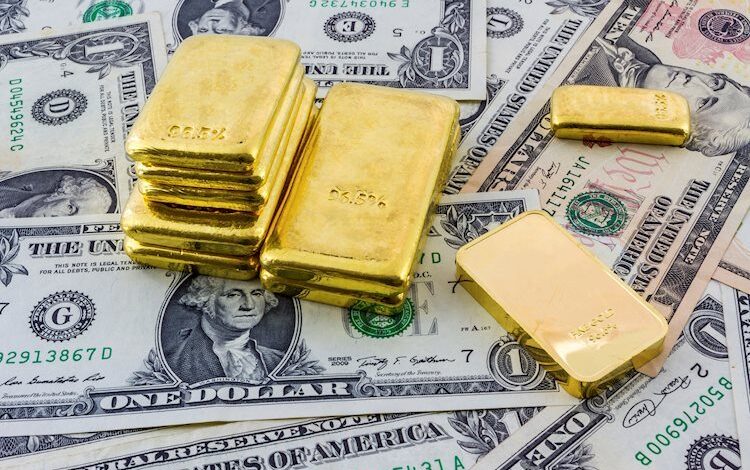Gold price bears have the upper hand amid fears of higher for longer Fed interest rates

- Gold price attracts some haven flows amid the cautious market mood, albeit lacks follow-through.
- Hawkish Fed expectations help limit a modest USD pullback from a multi-month top and cap gains.
- Traders now look forward to speeches by influential FOMC members for short-term opportunities.
Gold price (XAU/USD) struggles to gain any meaningful traction through the first half of the European session on Tuesday and languishes near a one-week low, around the $2,015 region touched the previous day. Expectations that the Federal Reserve (Fed) will keep interest rates higher for longer help limit a modest US Dollar (USD) profit-taking slide from almost a three-month high and act as a headwind for the non-yielding yellow metal.
The downside, however, remains cushioned in the wake of the cautious market mood, geopolitical risk and persistent worries about slowing economic growth in China, which tends to benefit the safe-haven Gold price. There isn’t any relevant market-moving data due for release from the US, leaving the USD at the mercy of speeches by influential FOMC members. This, along with the broader risk sentiment, should provide some impetus to the XAU/USD.
Daily Digest Market Movers: Gold price struggles near one-week low amid receding Fed rate cut bets
- Persistent worries about geopolitical tensions stemming from conflicts in the Middle East and slowing economic growth in China lend some support to the safe-haven Gold price.
- The US Dollar eases from its highest level in almost three months and further lends some support to the commodity, though hawkish Federal Reserve expectations act as a headwind.
- China’s Central Huijin Investment company reportedly said that it will increase its investment in Chinese stock ETFs and are determined to safeguard the stable operation of the market.
- The Institute for Supply Management (ISM) reported on Monday that the US services sector growth picked up pace in January amid an increase in new orders.
- The US ISM Non-Manufacturing PMI increased to 53.4 last month from 50.5 in December, with a measure of input prices or the Prices Paid sub-component rising to an 11-month high.
- This comes on top of Friday’s blowout US jobs report and reaffirmed the view that the economy is in good shape, diminishing the chances of an interest rate cut by the Fed in March.
- Moreover, hawkish comments by several Fed officials suggest that the first-rate cut might not come until May or June, which remains supportive of elevated US Treasury bond yields.
- The yield on the rate-sensitive 2-year US government bond eased from a one-month top on Monday and the benchmark 10-year US Treasury yield holds comfortably above the 4.0% mark.
- In an interview with the CBS News show 60 Minutes that aired on Sunday, Fed Chair Jerome Powell said that the central bank could be patient in deciding when to cut interest rates.
- Minneapolis Fed President Neel Kashkari argued that a possibly higher neutral rate means that the central bank can take more time to assess upcoming data before beginning interest rate cuts.
- Chicago Fed President Austan Goolsbee noted that there have been seven months of good inflation reports, though did not comment on the timing of the first interest rate cut.
Technical Analysis: Gold price consoldiates near one-week low before the next leg down
From a technical perspective, some follow-through selling below the $2,012-2,010 area might expose the $2,000 psychological mark. A convincing break below the latter will be seen as a fresh trigger for bearish traders and drag the Gold price to the 100-day Simple Moving Average (SMA) support, currently pegged around the $1,984-1,983 zone. The XAU/USD could eventually drop to challenge the very important 200-day SMA, near the $1,965 region.
On the flip side, momentum beyond the 50-day SMA, near the $2,033 area, is likely to confront resistance near the $2,054-2,055 zone ahead of the $2,065 region, or last week’s swing high. Given that oscillators on the daily chart are just holding in the positive territory, some follow-through buying has the potential to lift the Gold price towards the $2,078-2,079 region, or the YTD peak set in January. The subsequent move-up should allow the XAU/USD to reclaim the $2,100 mark and climb further to the next relevant hurdle near the $2,020 region.
US Dollar price today
The table below shows the percentage change of US Dollar (USD) against listed major currencies today. US Dollar was the strongest against the Japanese Yen.
| USD | EUR | GBP | CAD | AUD | JPY | NZD | CHF | |
| USD | -0.03% | -0.06% | -0.16% | -0.31% | -0.01% | -0.17% | -0.04% | |
| EUR | 0.03% | -0.04% | -0.15% | -0.29% | 0.01% | -0.14% | 0.00% | |
| GBP | 0.06% | 0.03% | -0.11% | -0.26% | 0.04% | -0.11% | 0.02% | |
| CAD | 0.15% | 0.14% | 0.11% | -0.15% | 0.15% | -0.01% | 0.13% | |
| AUD | 0.33% | 0.30% | 0.26% | 0.17% | 0.32% | 0.15% | 0.27% | |
| JPY | 0.03% | 0.00% | -0.06% | -0.15% | -0.31% | -0.14% | -0.02% | |
| NZD | 0.17% | 0.14% | 0.11% | 0.01% | -0.16% | 0.15% | 0.13% | |
| CHF | 0.02% | -0.01% | -0.04% | -0.12% | -0.29% | 0.02% | -0.15% |
The heat map shows percentage changes of major currencies against each other. The base currency is picked from the left column, while the quote currency is picked from the top row. For example, if you pick the Euro from the left column and move along the horizontal line to the Japanese Yen, the percentage change displayed in the box will represent EUR (base)/JPY (quote).
Gold FAQs
Why do people invest in Gold?
Gold has played a key role in human’s history as it has been widely used as a store of value and medium of exchange. Currently, apart from its shine and usage for jewelry, the precious metal is widely seen as a safe-haven asset, meaning that it is considered a good investment during turbulent times. Gold is also widely seen as a hedge against inflation and against depreciating currencies as it doesn’t rely on any specific issuer or government.
Who buys the most Gold?
Central banks are the biggest Gold holders. In their aim to support their currencies in turbulent times, central banks tend to diversify their reserves and buy Gold to improve the perceived strength of the economy and the currency. High Gold reserves can be a source of trust for a country’s solvency. Central banks added 1,136 tonnes of Gold worth around $70 billion to their reserves in 2022, according to data from the World Gold Council. This is the highest yearly purchase since records began. Central banks from emerging economies such as China, India and Turkey are quickly increasing their Gold reserves.
How is Gold correlated with other assets?
Gold has an inverse correlation with the US Dollar and US Treasuries, which are both major reserve and safe-haven assets. When the Dollar depreciates, Gold tends to rise, enabling investors and central banks to diversify their assets in turbulent times. Gold is also inversely correlated with risk assets. A rally in the stock market tends to weaken Gold price, while sell-offs in riskier markets tend to favor the precious metal.
What does the price of Gold depend on?
The price can move due to a wide range of factors. Geopolitical instability or fears of a deep recession can quickly make Gold price escalate due to its safe-haven status. As a yield-less asset, Gold tends to rise with lower interest rates, while higher cost of money usually weighs down on the yellow metal. Still, most moves depend on how the US Dollar (USD) behaves as the asset is priced in dollars (XAU/USD). A strong Dollar tends to keep the price of Gold controlled, whereas a weaker Dollar is likely to push Gold prices up.
Information on these pages contains forward-looking statements that involve risks and uncertainties. Markets and instruments profiled on this page are for informational purposes only and should not in any way come across as a recommendation to buy or sell in these assets. You should do your own thorough research before making any investment decisions. FXStreet does not in any way guarantee that this information is free from mistakes, errors, or material misstatements. It also does not guarantee that this information is of a timely nature. Investing in Open Markets involves a great deal of risk, including the loss of all or a portion of your investment, as well as emotional distress. All risks, losses and costs associated with investing, including total loss of principal, are your responsibility. The views and opinions expressed in this article are those of the authors and do not necessarily reflect the official policy or position of FXStreet nor its advertisers. The author will not be held responsible for information that is found at the end of links posted on this page.
If not otherwise explicitly mentioned in the body of the article, at the time of writing, the author has no position in any stock mentioned in this article and no business relationship with any company mentioned. The author has not received compensation for writing this article, other than from FXStreet.
FXStreet and the author do not provide personalized recommendations. The author makes no representations as to the accuracy, completeness, or suitability of this information. FXStreet and the author will not be liable for any errors, omissions or any losses, injuries or damages arising from this information and its display or use. Errors and omissions excepted.
The author and FXStreet are not registered investment advisors and nothing in this article is intended to be investment advice.


